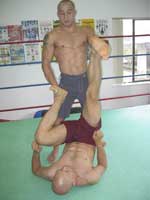
A few years ago Denis Kang and I published an article in Grappling Magazine about passing the guard in MMA. In that article we said there are three stages of getting past your opponent’s legs:
 “If your opponent is using a closed guard (i.e. his ankles crossed behind your back) then you first have to open his legs. Once his legs are open you have to establish some sort of control over his hips and legs, and then finally you have to pass over, under or around his legs.”
“If your opponent is using a closed guard (i.e. his ankles crossed behind your back) then you first have to open his legs. Once his legs are open you have to establish some sort of control over his hips and legs, and then finally you have to pass over, under or around his legs.”
Now, if you think about it, the reverse also applies. Here’s what I mean…
Let’s suppose that your opponent is in your guard. As long as you consistently block him at one of these three steps (opening the legs, controlling the hips, passing your legs), he’ll never be able to pass your guard.
After that article got published, ANOTHER training partner (with a very good and difficult-to-pass open guard) explained his secret strategy to me.
“As soon as I feel that my opponent is controlling my hips I go into emergency mode”, he said. “At that point I push his head, I bridge my hips, I kick my legs… I do whatever I need to do in order to get my hips free again”.
I’ll admit that, up until that conversation, I’d been a bit complacent about allowing opponents to control my hips. Sure, I’d try and block the guard pass, but I’d only start fighting hard during the very final stages of their guard passing efforts, rather than ‘getting serious’ about it a step earlier (during the battle for leg and hip control).
Since that day my guard has improved. I think that most of the improvements are due to fighting for leg and hip freedom earlier, and trying not to allow my opponent to move forward and impose his guard passing plan on me.
Don’t let your opponent control your hips!


